|
Gazetteer of Albanian Towns
A modest project to help five Villages of Elbasan.
In 1999 Dissident Editions proposed to "Friends of Albania" (Miqt� e Shqiperis�) in England a modest project on behalf of the donkeys (gomer�) of Albania, a country where veterinarians and veterinary services are very few. As a result of initial and anonymous funding by Dissident Editions, further cash was raised by the secretary and organiser of FoA, Miss Primrose Peacock. Veterinarians from England and Austria kindly offered their services at no cost, and, eventually, the Society for the Protection of Animals Abroad (SPANA) sponsored a Scottish veterinarian and offered literature in Albanian, tools and pharmaceuticals. The very wealthy British charity, The Donkey Sanctuary, refused to help the project in any way.
|
|
Elbasani
photo by Primrose Peacock Elbasan was - until the beginning of the Second World War - one of the most pleasant and unspoilt Ottoman cities in Albania, with a mixture of eastern and medieval buildings, narrow cobbled streets and a large bazaar where Turkish could still be heard. There was a clearly defined Christian settlement within the castle walls, a Vlach district on the outskirts of the city and several fine mosques and Islamic buildings. At the time the population was about 15,000 people. The distinguished English journalist J.D. Bourchier, then the Balkan correspondent of The Times, records that on a visit in 1911 he saw : the population celebrating Bairam in central space : wonderful primitive merry-go round with gypsy minstrels (flute and drum), pushed round by the men with poles; also a cartwheel poised on a tree top; pekhilvans(clowns) wrestling, mostly refugees from Dibra, thus gaining a precarious livelihood. Elbasan came into prominenece in the Roman period when it was known as Masio Scampa. The word Scampa means rocks or peaks in the ancient Illyrian language. The Romans built a substantial fortress here, about 300 meters square, protected by towers. In the 3rd and 4th centuries it became known as Hiskampis. It had developed as an important trade and transport centre near the junction of two branches of the Via Egnatia coming from Apollonia and Dyrrachium. Ptolemy wrote that it was the town of the Eordaei tribe, who later migrated to Macedonia. It took part in the spread of Christianity along the Via, and had a bishop, cathedral and basilicas as early as the 5th century. But as a town in a wide river valley, it was vulnerable to barbarian attacks once the legions were withdrawn, and despite the efforts of the Emperor Justinian to improve the fortications. Hiskampis was destroyed by the Bulgars and Ostrogoths during the Slav invasions of the Balkans. Although some semblance of urban and military life must have continued for a time, as it is mentioned in the work of Procopius of C�sarea in the 6th century, it was totally destroyed by the Bulgars in intermittent attacks over the next 200 years. The site seems to have been abandoned until the Ottoman invaders built a military camp here, followed by urban reconstruction under Sultan Mehmet II in 1467, who constructed a massive four-sided castle, with a deep moat and three gates. He named it Ilibasan, meaning 'strong place' in Turkish. It became a centre of Ottoman urban civilisation over the next 400 years. By the end of the 17th century it had 2000 inhabitants. The fortress was dismantled by Reshit Pasha in 1832. In 1909, after the 'Young Turk' revolution in Istanbul, an Albanian National Congress was held here to study educational and cultural questions. (Elbasan had the first teachers' training college in Albania.) The delegates, all from central and southern of Albania, endorsed the decision of the Congress of Monastir (modern Bitola, FYROM) to use the Latin alphabet rather than the Arabic script in written Albanian. The Muslim majority opposed the installation of Prince William of Weid in 1914. Elbasan was occupied successively by Serbs, Bulgars, Austrians and Italians between 1915 and 1918. Industrial development began in the Zogist period when tobacco and alcoholic drinks' factories were established.
photo by Primrose Peacock The city was also noted for its good public buildings, advanced education provision, public gardens and timber-built shops. But there was much wartime damage and an intensive programme of industrial development in the Communist period that boosted the city to around 75,000 inhabitants, and the rection of many ugly modern structures. The culmination of this process was the construction of the huge 'Steel of the Party' metallurgical complex outside the city, in the valley of the Shkumbini, built with Chinese assistance in 1960s and 1970s. It was called "The Second National Liberation of Albanian" by Enver Hoxha. with its chimneys, the tallest in the Balkans, always belching smoke and emitting a stream of dangerous pollutants - which soon meant that much of the hitherto prosperous agricultural area in the river valley was useless for all crops.
Hotel Skampa, Elbasan
|






